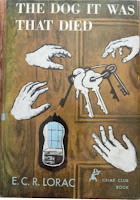It's time to put together my wrap-up post for July. I also have a contribution for Kerrie's Crime Fiction Pick of the Month. I got a fair amount of reading done--though it does look like I need to reevaluate the number of pages I'm going to get read per year. I used to average over 40,000 pages. I'm going to be lucky to hit 30,000 this year. But..let's focus on July. Here's what happened here on the Block last month....
Total Books Read: 14
Total Pages: 3,137
Average Rating: 3.43 stars Top Rating: 5 stars
Percentage by Female Authors: 36%
Percentage by US Authors: 57%
Percentage by non-US/non-British Authors: 7%
Percentage Mystery: 100% Percentage Fiction: 100%
Percentage written 2000+: 29%
Percentage of Rereads: 14%
Percentage Read for Challenges: 100% {It's easy to have every book count for a challenge when you sign up for as many as I do.} Number of Challenges fulfilled so far: 19 (59%)

AND, as mentioned above, Kerrie had us all set up for another year of Crime Fiction Favorites. What she was looking for is our Top Mystery Read for each month. July was a hugemonth for mysteries with 100% coming from that field--for a total of fourteen crime novels. Here are the books read:
The Decagon House Murders by Yukito Ayatsuji (4 stars)
A Pinch of Poison by Frances & Richard Lockridge (5 stars)
All Fall Down by L. A. G. Strong (3 stars)
The Ticking Clock by Frances & Richard Lockridge (2 stars)
Checkmate to Murder by E. C. R. Lorac (4 stars)
The Poet's Funeral by John M. Daniel (2 stars)
The Devil in Bellminster by David Holland (3 stars)
The Red House Mystery by A. A. Milne (4 stars)
The Warsaw Anagrams by Richard Zimler (4 stars)
Too Good to Be True by J. F. Hutton (3 stars)
A Cold Day for Murder by Dana Stabenow (3 stars)
A Dead Man in Athens by Michael Pearce (3 stars)
The Nine Tailors by Dorothy L. Sayers (5 stars)
The Mirabilis Diamond by Jerome Odlum (3 stars)
As we can see, two books came away with 5 stars--A Pinch of Poison by Frances & Richard Lockridge and The Nine Tailors by Dorothy L. Sayers. However, both of these are rereads and the authors have already walked away with the P.O.M. award in previous years. I like to spread the wealth here at the Block. In the next tier (4 stars), we have The Decagon House Murders by Yukito Ayatsuji, Checkmate to Murder by E. C. R. Lorac, The Red House Mystery by A. A. Milne, and The Warsaw Anagrams by Richard Zimler.
The Lorac book is another excellent fog-shrouded police procedural starring Inspector MacDonald with delightful characterization. But Lorac has won before, so out she goes. The Red House Mystery is Milne's only adult detective novel. And it is a very nice Golden Age offering with lots of fun banter between the amateur detective, Antony Gillingham, and his "Watson," Bill Beverley, but not quite a P.O.M. winner. And then there were two. Which provides a suitable intro to the first of our finalists. Ayatsuji's The Decagon House Murders is a daring homage to the Golden Age detective novel and, most particularly, to Agatha Christie's classic impossible crime novel, And Then There Were None. This is a highly enjoyable puzzle-plot mystery. Since it is focused on the puzzle aspect, the characterization suffers a bit, but not enough to keep mystery fans from enjoying themselves. The solution to the mystery is quite audacious and, while I kept wondering if perhaps X might be the killer, I couldn't figure out how it would be possible. The clues are there if you just know how to interpret them. Our other finalist, The Warsaw Anagrams (2009) by Richard Zimler, is a heartbreaking historical thriller set in the Warsaw Ghetto during World War II. It centers on the murders and disfigurement of Jewish children--and specifically on the murder of Erik Cohen's nephew. Erik sets out to discover who is killing so specifically in the shadow of the Nazi regime's extermination camps.
But we can't have two winners, so our July P.O.M. Award goes to The Warsaw Anagrams by Zimler.
Zimler creates a very moving and intriguing story in the midst of the overall horror of the Nazis' atrocities. He also creates a sense of hope in the midst of hopelessness by focusing on the simple, everyday activities of the Jewish people within the Ghetto--from the children going secretly to school and forming a choir to the small kindnesses that neighbors extend to one another to the few Polish Christians who risk punishment by providing what they can for the Jews they know behind the barbed wire. It is an absorbing and heart-breaking story and well worth your time whether you are looking for a World War II setting or a mystery thriller.

















